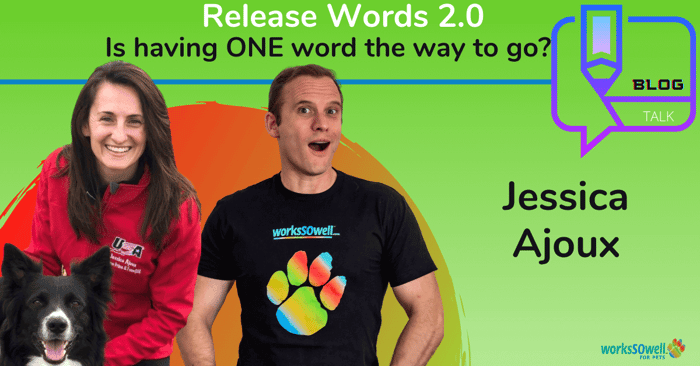Release Words 2.0
In this live interview, dog agility champion Jessica Ajoux will teach us a new and refined way of understanding release words with Release Words 2.0. She will answer your burning questions such as: why the right release words affect your k9’s response. Are all release words created equal? And is it better to have one or multiple release words?
Understanding how release words work and how your dog understands them is not only important, but it also strengthens your bond with your furry friend.
Click below to watch the full live interview with Jessica Ajoux
What is a Release Word?
A release word doesn’t make sense unless you think of a stay. They need to understand when they are supposed to be moving and when they are not supposed to. A release word is a verbal cue that tells your dog the stay is over and they can now move.
- Common release words are: okay, break, free, release, and more. It doesn’t matter what the word is; it’s just the signal that they have to understand. Jessica uses “break” for over 50% of her dogs, and some use “okay.”
- A release word is crucial because without it, you don’t have a stay, or you at least don’t have a set duration. “BREAK” or “OK” (or whatever the release words is) tells the dog he no longer has to stay.
- Agility is not getting simpler; we are teaching our dogs many more things. Jessica was training one of her dogs, Fame, being super strict in terms of not moving until Jessica says “break.” Now when Jessica says “break,” she moves very quickly to do the thing she is thinking of, but what is she actually supposed to do? If you wanted her to come to you after she is released, hopefully they hear your recall word after they hear your release word. This is why having multiple release words may be more clear for the dog.
Instructional Release Words
- If Fame only knows that “break” means to start doing something, what is that something? Let’s use the example of a dog who understand how to go to the backside of a jump. Typically, the dog would be in a stay, so once you release them, they would just jump the jump from the front side. But if you say “break,” and then “push” as the backside cue, it’s either a little delayed, or they didn’t listen to it in the first place. It’s a two-step process if you only have one release cue.
- This is why Jessica thought she should be releasing her dog with instructions. Instead of saying “okay” and then the backside cue, what if she just told her dog “backside cue?” That allows the dog to have the info while they are still stationary, and with that cue, they can immediately go there instead of having to correct the dog’s mind and behavior.
- Picture this example. You have told your dog to STAY while out at the park, and your dog notices a squirrel is moving around. If you want your dog to come to you rather than running towards the squirrel, you will need to give them your RECALL word. If the dog is thinking “SQUIRREL” in their mind while holding the stay, and you give your release word… they will likely immediately run towards the squirrel. If you then say “HERE” (or whatever your recall word is)… they *should* come to you and abandon chasing the squirrel, but they will have already taken a few steps towards that squirrel instead of immediately coming to you. Instead of saying “okay” and then “come,” you could just say “come.” That indicates to the dog that you want the dog to come to you, which does not involve the squirrel they were thinking of.
- Jessica can affirm this process definitely works. She likes to figure things out on her own or know the reasoning behind something before adopting anything. So she does things because she thinks it’s the right thing to do, which is indicated by how the dogs respond. She applied this system of instructional release words to her own training and her dogs immediately understood. She saw the difference and could clearly see the benefit in using more than one release word.
- She knew there was something to be considered about this topic because previously, she could say “break” and release the dog. But in the situation of, say, a lateral leadout, if you leave the dog in a stay and the handler goes far away from the dog, when you say “okay,” dogs usually want to run toward you. If you want that dog to move away, she would say “out” or “go,” which got the dog to move in that direction. She would not say “OK” before that “OUT/GO”. So she already had some exceptions within her system to correct their thinking in unique situations. When you have more and more exceptions, you may need to review the rule.
- Allowing the dog to release from their position with instructional cues has worked much better. Jessica has been applying it to her new puppies from the beginning and changing it for her current dogs. The only struggle she’s run into is with one of her older dogs, Fame; she is the type who moves and then thinks, so Jessica wishes she had taught her this years ago.
- An example of an instructional release word is moving your dog from a sit into a down. You don’t tell them “okay,” then “down.” You just tell them “down,” which tells them that they can move and this is how you want them to move.
- Another example is a dog is in a stop contact in an agility course, and up next is the weave poles, instead of saying “okay, weave,” just say “weave” so that your dog can just look for the poles and go. Sometimes you don’t see it as graphically because the dog may already be thinking of what you want them to do, but if there is more than one option of what they could do next, why not tell them which one you want right off the bat? It’s easier and clearer.
- Your stay will deteriorate only if you are not consistent in requiring that the dog wait for a verbal cue before moving from that stay. Having multiple instructional release words has no impact in Jessica’s experience. It’s just good old inconsistency that ruins stays.
- When dogs are thinking, they often slow down. Jessica wouldn’t be surprised that if you set this up for the first time, and your dog is in a stay, and you say “here” (Jessica’s word to come to her), they may freeze and not move right away. They could be thinking how different this experience is, or they were maybe thinking “jump,” so when they hear “here,” it takes them a second to switch their brain. Freezing usually indicates that they’re not sure what you’re asking for.
- Instructional releases are very helpful when teaching new behaviors on obstacles that can be performed in many different ways. Think of a jump for example. Dogs can do lots of things with a jump. They can jump the front, the back, jump in collection, turn left, turn right… If they know one of these options really well, and you want them to learn about a new option, using a typical release word won’t help your cause. You’re better off giving a specific instruction. That is the biggest place Jessica has seen value in using this particular release word technique.
Contact Jessica
Additional Resources









